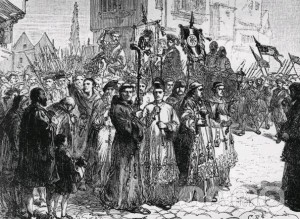 4 October in Tudor history saw two interesting events: trouble in Horncastle, Lincolnshire, in 1536 which led to the Pilgrimage of Grace rebellion, and in 1556 Sir John Cheke, one time tutor to Edward VI, Secretary of State for Lady Jane Grey and the first Regius Professor of Greek at Cambridge University, making a public recantation of his Protestant faith in front of Mary I.
4 October in Tudor history saw two interesting events: trouble in Horncastle, Lincolnshire, in 1536 which led to the Pilgrimage of Grace rebellion, and in 1556 Sir John Cheke, one time tutor to Edward VI, Secretary of State for Lady Jane Grey and the first Regius Professor of Greek at Cambridge University, making a public recantation of his Protestant faith in front of Mary I.
The Lincolnshire Rising
On this day in history, Wednesday 4th October 1536, there was trouble in Horncastle, Lincolnshire, part of what we know as the Lincolnshire Rising which, in turn, was part of the Pilgrimage of Grace rebellion.
Dr Raynes, the chancellor of the Bishop of Lincoln, who was staying nearby at Bolingbroke, after having held a session of the commissionary’s court there, was dragged from his sickbed and taken to Horncastle. Francis Aidan Gasquet, the 19th century Benedictine monk and historical scholar, describes what happened next in his book Henry VIII and the English Monasteries:
As the chancellor rode into the field with his captors the passions of the mob were stirred, and there occurred one of the two acts of violence, which alone in this or the subsequent Yorkshire rising, disgraced the movement! “At his coming into the field,” declares Brian Staines, ” the rebels, whereof were many parsons and vicars, cried out with a loud voice, ‘ Kill him, kill him.’ And upon that one William Hutchinson, of Horncastle, and William Balderstone, by the procurement of the said parsons and vicars, pulled him violently off his horse, kneeling upon his knees, and with their staves they slew him. And being dead, this deponent saith the priests continually crying, ‘ Kill him, kill him,’ he also struck the said chancellor upon the arm with a staff.
Sir John Cheke’s Public Recantation
On this day in 1556, Sir John Cheke, one time tutor to Edward VI, Secretary of State for Lady Jane Grey and the first Regius Professor of Greek at Cambridge University, made a public recantation of his Protestant faith in front of Mary I.
Cheke had been imprisoned in the Tower of London by Mary I for his part in Lady Jane Grey’s ‘usurpation’ of the throne in July 1553 but was released just over a year later. He then travelled to the continent but was arrested between Brussels and Antwerp in Spring 1556, along with Sir Peter Carew, and taken back to England, where he was once again imprisoned in the Tower.
In fear of being burned at the stake for his Protestant beliefs, he professed his Catholic faith in a letter to Cardinal Pole in July 1556. This was not enough. Cheke had to formally submit to the Cardinal, be accepted back into the Catholic Church and then make a public recantation in the presence of the Queen and court. On 4th October 1556, he stood before them and made the following recantation:
The staves and swords used from that day are preserved in the parish church in Horncastle. I think that the passions were running high; the two murders seem a bit over the top and bayinr for blood a bit harsh, but these people had witnessed the destruction of their heritage, their daily lives were governed by religious fervour and direction, the hours of the day, the seasons, the harvests, the feast days, fast days, and so on were all marked out by religious observance and devotion. Now all that was under threat and the Kings commissioners were nothing more than royal appointed vandals as far as the people of Lincolnshire and Yorkshire were concerned. They were not merely a mob either, they had formulated a list of demands; they had a manifesto, and Henry’s response is certainly telling them NO in more ways than one. It must have been a very tense situation, it is actually a wonder more people were not hurt or killed in the clashes as these people were obviously desperate to make their feelings and their voices heard and to oppose the destruction of abbeys and churches and the ruin of all they believed and held precious.